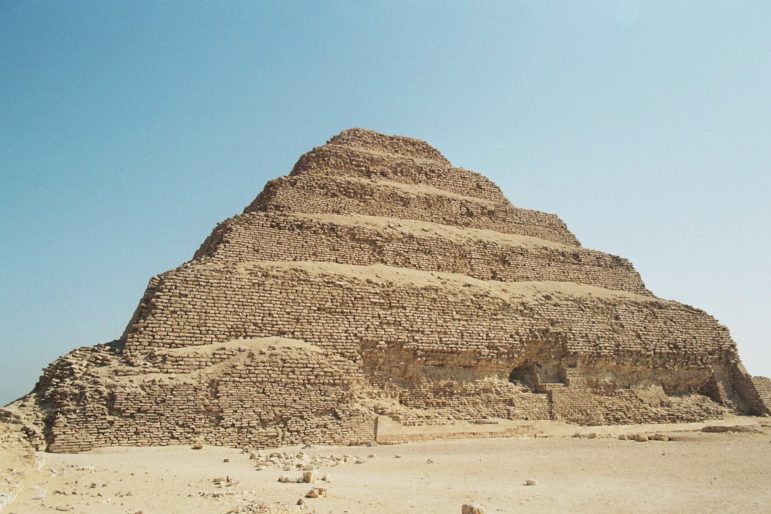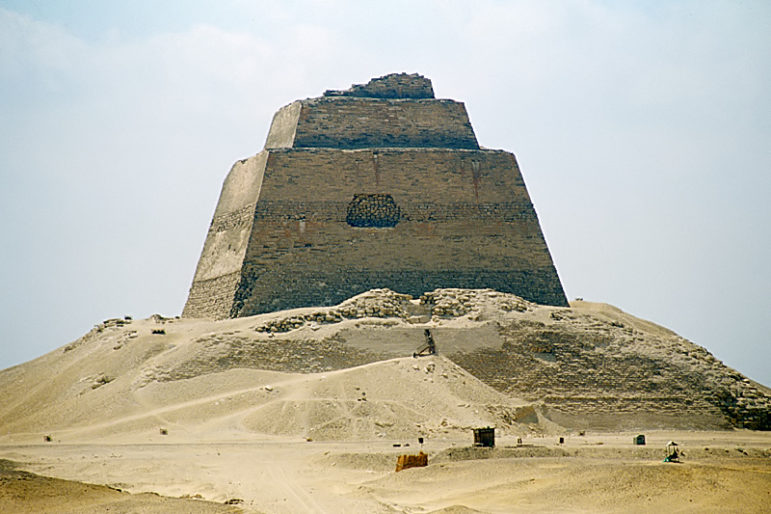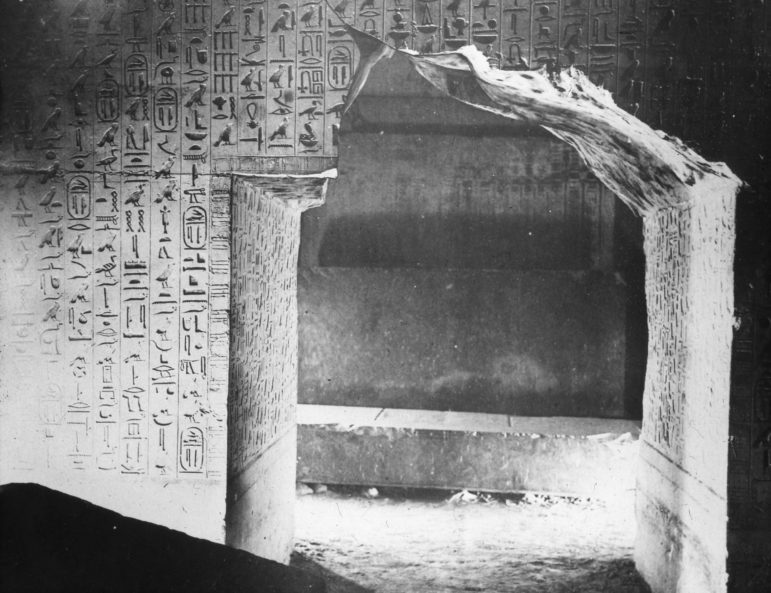TWH – The architecture of spiritual structures frequently reflects the beliefs of that spirituality. Modern Pagans do something similar in the construction of home altars, shrines, and sacred spaces. In Past as Prologue: Connecting the Old Kingdom to the New: Meanings in Architecture, Brian Alm argues that the architecture of ancient Egyptian tomb complexes reflected their beliefs about the afterlife.
Among upper-class ancient Egyptians, tombs never stood alone. Neither were they only pyramids. Multi-structure tomb complexes contained their tombs. Alm focused on four elements of a tomb complex.
First, tomb complexes contained passageways with a large number of structurally unnecessary turns. Second, the complex contained an open-air courtyard for communion with the sun. Third, architecture tended to ease the soul’s journey journeyed westward to Eternity. Fourth, the soul rose upwards from the depths to the circumpolar stars.
The Egyptians developed these beliefs in the Old Kingdom, from roughly 2600 to 2100 B.C.E. Echoes of those structures occurred in the New Kingdom, from 1550 to 1069 B.C.E. Alm did not discuss the Middle Kingdom, from 2055 to 1650 B.C.E.
Dynasty III (2686 to 2613 B.C.E.), Old Kingdom
The Old Kingdom lasted from Dynasty III through Dynasty VI. Before pyramids, Egyptians buried their dead in “mastabas,” rectangular, mudbrick structures with flat roofs and inward sloping sides.

Djoser Step Pyramid at Saqqarah – Image credit: François Philipp, CC BY-SA 3.0
In Dynasty III, the Pharaoh Djoser built the Step Pyramid. It consisted of five mastabas built, one on top of the other. As they rose, each slab was smaller than the one beneath, giving it a pyramidal appearance.
The Step Pyramid formed part of a tomb complex. Someone would enter the complex through a door at the southeast corner. The door would open to a passageway which would lead to a long colonnade. That colonnade would end in a sharp right turn, opening into a great open courtyard. That courtyard occupies most of the space south of the Step Pyramid. Almost all the other structures in the complex lie in the northern end.
Dynasty IV (2613 to 2494 B.C.E.), Old Kingdom
Pharaoh Sneferu attempted to build two pyramids, the Meidum and the Bent Pyramid. His architects were, frankly, experimenting with pyramid construction. The Meidum Pyramid collapsed during construction. During the construction of the Bent Pyramid, its architects had to change the angle of its rise from 54o to 43o.

North side of the Snofru Pyramid, Meidum, Egypt – Image credit: Roland Unger, CC BY-SA 3.0
Egyptian tomb complexes contained a mortuary temple. That temple would be the site for the cult of the Pharaoh. The Meidum Pyramid contained what would have been Sneferu’s mortuary temple. That temple had four turns in its passageway, doubling back on itself. The passageway opened into an open-air courtyard with an offering table.

Ruined mortuary temple, photo taken from an elevated position on the western side – Image credit: Ludwig Borchardt – Public Domain
In the Bent Pyramid tomb complex, its mortuary temple had a side entrance. It would open into the mortuary hall. From the hall, the passageway would lead to a small open courtyard. Its side entrance would open into a mortuary hall and then would turn to a small open courtyard. In that courtyard, two vertical slabs flanked an offering table.

Pharaoh Sneferu’s Bent Pyramid in Dahshur – Image credit: Ivrienen at English Wikipedia, CC BY 3.0
Both of Sneferu’s pyramids had passageways with unnecessary turns. They also contained a courtyard opening to the sky. Another commonality lay in the placement of the mortuary temple on the east side of the tomb complex. In Egyptian belief, the soul of the deceased traveled from east to west, like the journey of the sun.
According to Alm, only the perspective of the soul inside of a pyramid has meaning. The Egyptians built these tomb complexes to ease the soul’s journey to the afterlife. How the soul moved in the afterlife forms the key to understanding the logic and language of the architecture of a tomb complex.
Alm argued that the structurally unnecessary turns of these tomb complexes reflected the challenges that the soul would encounter in the afterlife. The open-air courtyard, in contrast to roofed temples, reflected the increasing importance of the cult of Ra, the sun god.
Dynasty V (2494 to 2345 B.C.E.), Old Kingdom
Alm argued that the pharaohs of Dynasty V favored and built up the cult of Ra. That cult had its center in Heliopolis. The pharaohs of this dynasty increasingly identified themselves with the sun god, Ra. Almost all pharaohs of this dynasty included “Ra” in their names.
Each day the sun re-enacted a cycle of rebirth. At sunrise, the sun was reborn. At sunset, it died. The reborn god of the sunrise had the name “Ra-Horakhty.”
Pharaoh Userkaf placed his mortuary temple on the south side of his tomb complex. Prior pharaohs had placed it on the east side. He did so to ensure that the sun’s rays would always shine into his temple. Dynasty V pharaohs had open-air altars in their mortuary temples. That allowed the light of the sun to fall onto those altars.
His tomb complex had a massive pedestal with an obelisk in the middle of the upper temple. Alm argued that an obelisk symbolized the sun. Alm did not discuss its more obvious symbolism. Nearby, stood an altar to the sun.
The importance of the tomb complex of Pharaoh Unas stems from the presence of pyramid texts painted on the walls. It marks the first known time that they appeared. The pyramid texts gave instructions to the traveling soul. They are inscribed on the inner walls of the tomb complex. Some of these same texts would later appear in tomb complexes of the New Kingdom.

Pyramid text of Pharaoh Unas – Image credit: Brooklyn Museum – originally posted to Flickr as Egypt: Sakkara – Public Domain,
Dynasty VI (2345 to 2181 B.C.E.), Old Kingdom
Nearby the Step Pyramid of Djoser lie two mastabas from Dynasty VI. They belong to two high-ranking administration officials, Mereruka and Kagemni. The mastaba of Mereruka had 33 rooms with many turns in its passageway. That of Kagemni also had many turns. In both mastabas, those turns served no identifiable function.
Echoes of these forms in the New Kingdom
Alm found echoes of these form reappearing in the tomb complexes and pharaonic practices of the New Kingdom (1550 to 1069 B.C.E.). Eleven of the eighteen pharaohs in Dynasties XIX and XX had the element “Ra” in the name. Ramesses may be the most famous pharaonic name of all. In the New Kingdom, Akhenaten (1353 to 1336 B.C.E.) brought the sun cult to its most extreme. He tried to replace the entire pantheon of Egypt with the single worship of the Aten, the sun disk.
The relationship between pharaonic beliefs and tomb architecture may be impossible to prove. Alm has proposed one way to understand it. In so doing, he has shown how ancient Egyptian polytheism may have evolved over time. His theory may also explain how Atenist monotheism emerged from Egyptian polytheism.
The Wild Hunt is not responsible for links to external content.
To join a conversation on this post:
Visit our The Wild Hunt subreddit! Point your favorite browser to https://www.reddit.com/r/The_Wild_Hunt_News/, then click “JOIN”. Make sure to click the bell, too, to be notified of new articles posted to our subreddit.
